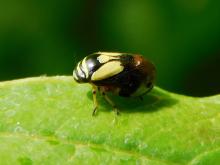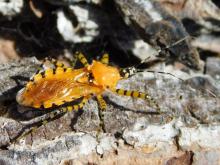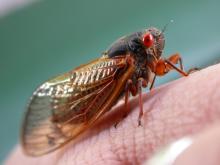Land Invertebrates
Media

Species Types
Scientific Name
Clastoptera proteus
Description
The adult dogwood spittlebug has distinctive black and yellow markings. It feeds on dogwoods, blueberries, and their relatives.
Media

Species Types
Scientific Name
Neacoryphus bicrucis
Description
The white-crossed seed bug, or ragwort seed bug, has a prominent thin-lined pale X dividing zones of red and black. Look for it in places where ragworts are plentiful.
Media

Species Types
Scientific Name
Lygaeus kalmii
Description
The small milkweed bug is one common type of seed bug. It is found on many more plants than just milkweeds.
Media

Species Types
Scientific Name
More than 40 species in 3 genera in North America north of Mexico
Description
Ebony bugs are definitely true bugs, but they look a lot like tiny, shiny black beetles. Their bodies are fat ovals. They’re almost always seen on flower clusters and immature seeds, often on members of the carrot or parsley family.
Media

Species Types
Scientific Name
Oncopeltus fasciatus
Description
The large milkweed bug, with its bold black-and-orange pattern, is one of the most beautiful of the true bugs. Look for it on milkweeds, from midsummer through the first hard freeze.
Media

Species Types
Scientific Name
Pselliopus barberi
Description
The orange assassin bug, Pselliopus barberi, is about ½ inch long and is one of our most attractive non-butterfly insects. They overwinter in groups as adults under loose bark.
Media

Species Types
Scientific Name
About 2,000 species in North America north of Mexico
Description
Plant bugs, or mirids, are a huge family of true bugs. They are often overlooked — except by gardeners and farmers. Most mirids eat plants, and some are agricultural pests. As a group, they’re an important food source for birds and other insectivores.
Media

Species Types
Scientific Name
Pachypsylla spp.
Description
Hackberry psyllids are a genus of tiny, planthopper-like bugs. As larvae, they develop within the leaves, twigs, buds, or bark of hackberry trees. The trees form warty galls in response to their presence. In the fall, tiny adult hackberry psyllids cling to window screens.
Media

Species Types
Scientific Name
Magicicada spp.
Description
Periodical cicadas live as nymphs for 13 or 17 years underground, and then emerge simultaneously to metamorphose into their adult form. Tremendous numbers of periodical cicadas, calling all at once, are a memorable event.
See Also



Media

Species Types
Scientific Name
Cisseps fulvicollis
Description
The yellow-collared scape moth is more often “orange-collared.” And whether you think it looks more like a firefly or a wasp, it’s still a moth!
Media

Species Types
Scientific Name
Nearly 150 species in North America north of Mexico
Description
Slim, delicate plume moths are instantly recognizable by their T-shaped silhouette, long legs, and muted shades of tan and brown. It can be hard to separate the various species.
Media

Species Types
Scientific Name
Pyrrharctia isabella
Description
Not many people know the adult Isabella tiger moth when they see one, but we’re all acquainted with its caterpillar, the woolly worm, or woolly bear.
About Land Invertebrates in Missouri
Invertebrates are animals without backbones, including earthworms, slugs, snails, and arthropods. Arthropods—invertebrates with “jointed legs” — are a group of invertebrates that includes crayfish, shrimp, millipedes, centipedes, mites, spiders, and insects. There may be as many as 10 million species of insects alive on earth today, and they probably constitute more than 90 percent all animal species.





















